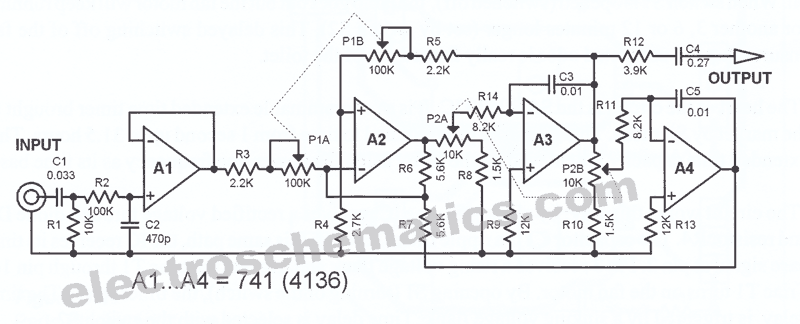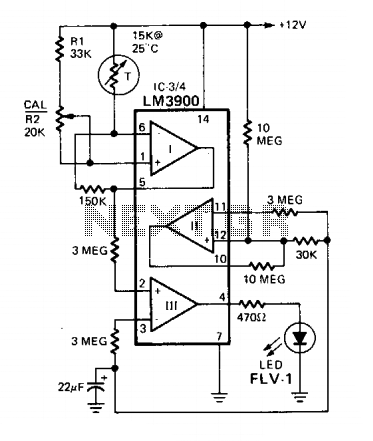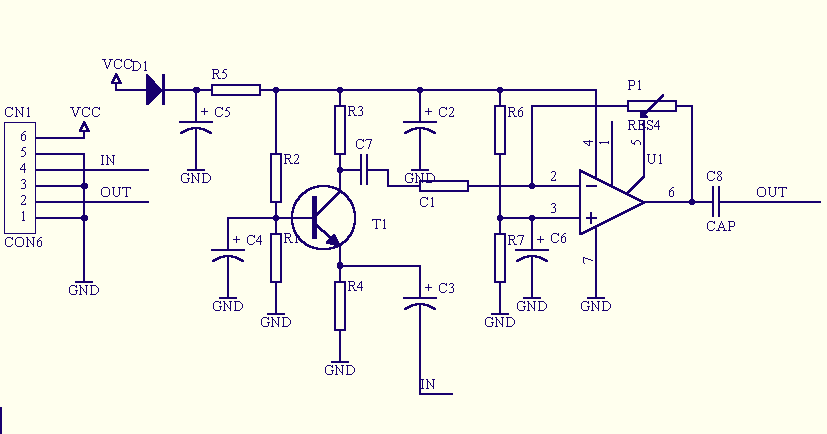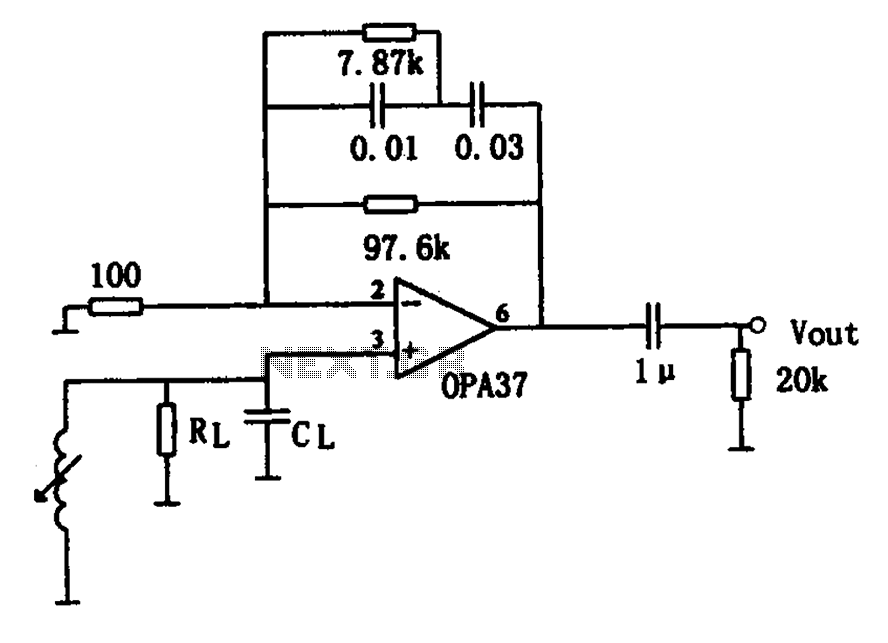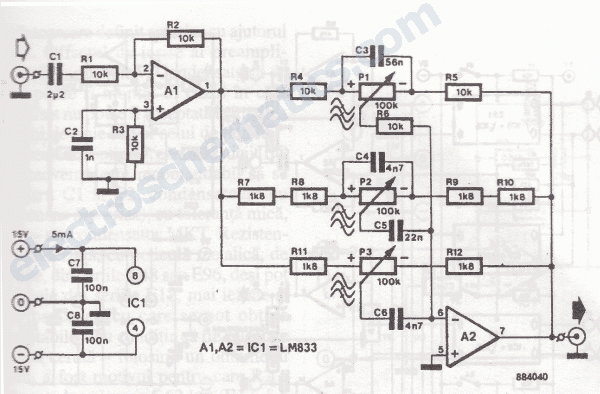
Car audio amplifier
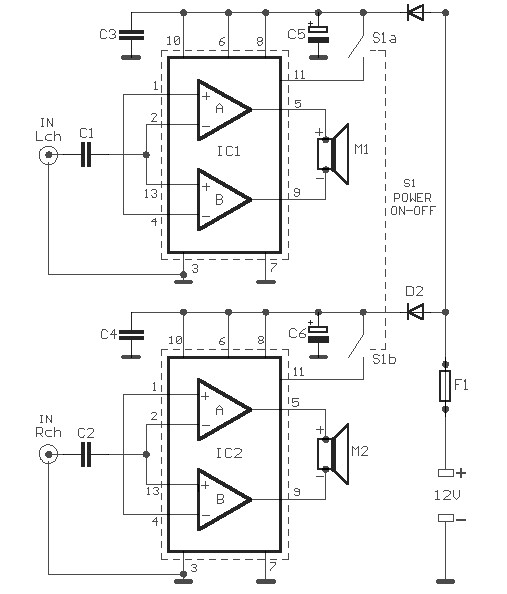
Car audio amplifier schematic diagram. Given the voltage of the car is +12 V, there is an opportunity to take power over a threshold. The solution involves using two amplifiers in a bridge connection, theoretically quadrupling the output power and, at best, doubling it. This 20-watt car audio amplifier circuit described here offers a 20-watt booster that can increase the power output from the car stereo to a maximum of 20 watts. The input is connected to the output of the receiver, and the output is connected to the speaker as shown in the car audio amplifier schematic. It is crucial to ensure that the speaker is not connected to the chassis (ground); otherwise, the integrated circuit IC1, a TDA2004, may be damaged.
The car audio amplifier circuit utilizes a dual amplifier configuration to enhance audio output effectively. The TDA2004 integrated circuit serves as the core of the amplifier, providing a robust platform for audio amplification. It is designed to operate with a supply voltage of +12 V, which is standard in automotive applications.
In a bridge configuration, two TDA2004 amplifiers are employed, allowing for increased output power. This setup effectively doubles the voltage swing across the speaker, leading to a theoretical output power of 40 watts. However, practical limitations, such as thermal dissipation and speaker impedance, may result in a maximum achievable output of around 20 watts.
The input stage of the circuit is connected to the output of the car's audio receiver, which provides the audio signal to be amplified. The output of the TDA2004 is then connected directly to the speaker. It is essential to ensure that the speaker is isolated from the vehicle's chassis ground to prevent potential damage to the amplifier. This isolation can be achieved by using isolated speaker terminals or employing a transformer to decouple the speaker from the ground.
Additionally, the circuit should include appropriate filtering capacitors at the power supply pins of the TDA2004 to ensure stable operation and minimize noise. Bypass capacitors close to the power supply pins can help in reducing high-frequency noise, ensuring a clean audio output.
In summary, this car audio amplifier circuit is a practical solution for enhancing the audio experience in a vehicle, providing a significant increase in output power while maintaining the integrity of the audio signal. Proper implementation of the circuit, along with attention to grounding and power supply decoupling, will yield optimal performance.Car audio amplifier schematic diagram. Given the voltage of the car is +12 V, we have the opportunity to take power over a threshold. The solution is to use two amplifiers in bridge connection, so the output quadrupled, at least theoretically, and at best, doubled. This 20w car audio amplifier circuit described hereoffers a20 wattboosterthatwillal low youtorealize thepower amplifierwith which one canincrease the poweroutputfromthe carstereoup to20Wattsmaximum. The inputINis connected to theoutputof thereceiver, Uoutputis connectedto the speakeras shownoncaraudioamplifierscheme.
It is veryimportanttoensurethat thespeakerhas no connection tothe chassis(ground)ifnot, the integrated circuitIC1, aTDA2004will. 🔗 External reference
The car audio amplifier circuit utilizes a dual amplifier configuration to enhance audio output effectively. The TDA2004 integrated circuit serves as the core of the amplifier, providing a robust platform for audio amplification. It is designed to operate with a supply voltage of +12 V, which is standard in automotive applications.
In a bridge configuration, two TDA2004 amplifiers are employed, allowing for increased output power. This setup effectively doubles the voltage swing across the speaker, leading to a theoretical output power of 40 watts. However, practical limitations, such as thermal dissipation and speaker impedance, may result in a maximum achievable output of around 20 watts.
The input stage of the circuit is connected to the output of the car's audio receiver, which provides the audio signal to be amplified. The output of the TDA2004 is then connected directly to the speaker. It is essential to ensure that the speaker is isolated from the vehicle's chassis ground to prevent potential damage to the amplifier. This isolation can be achieved by using isolated speaker terminals or employing a transformer to decouple the speaker from the ground.
Additionally, the circuit should include appropriate filtering capacitors at the power supply pins of the TDA2004 to ensure stable operation and minimize noise. Bypass capacitors close to the power supply pins can help in reducing high-frequency noise, ensuring a clean audio output.
In summary, this car audio amplifier circuit is a practical solution for enhancing the audio experience in a vehicle, providing a significant increase in output power while maintaining the integrity of the audio signal. Proper implementation of the circuit, along with attention to grounding and power supply decoupling, will yield optimal performance.Car audio amplifier schematic diagram. Given the voltage of the car is +12 V, we have the opportunity to take power over a threshold. The solution is to use two amplifiers in bridge connection, so the output quadrupled, at least theoretically, and at best, doubled. This 20w car audio amplifier circuit described hereoffers a20 wattboosterthatwillal low youtorealize thepower amplifierwith which one canincrease the poweroutputfromthe carstereoup to20Wattsmaximum. The inputINis connected to theoutputof thereceiver, Uoutputis connectedto the speakeras shownoncaraudioamplifierscheme.
It is veryimportanttoensurethat thespeakerhas no connection tothe chassis(ground)ifnot, the integrated circuitIC1, aTDA2004will. 🔗 External reference
Warning: include(partials/cookie-banner.php): Failed to open stream: Permission denied in /var/www/html/nextgr/view-circuit.php on line 713
Warning: include(): Failed opening 'partials/cookie-banner.php' for inclusion (include_path='.:/usr/share/php') in /var/www/html/nextgr/view-circuit.php on line 713

